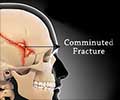British scientists have found fundamental differences between the bone which makes up the skull and the bones in our limbs.
Scientists at Queen Mary, University of London believe the findings could hold the key to tackling bone weakness and fractures.It is well know that bones in the arms and legs become weak and vulnerable to breaks when they are not maintained by weight bearing exercise. However skull bone, which bears almost no weight remains particularly resistant to breaking.
In the new research published in PLoS ONE, researchers say that their new understanding of the differences between the two types of bone could lead to new ways to treat or prevent osteoporosis.
People who develop osteoporosis have fragile bones which are prone to breaking. The condition becomes more common as we age, especially in post-menopausal women when levels of oestrogen fall dramatically. In the over 50s it affects half of all women and a fifth of all men.
The researchers wanted to understand why the skull bones are resistant to bone thinning as they age, even in post-menopausal women.
To investigate this, they looked in detail at rat bone cells from the skull and compared them with cells from limb bone. They found differences between the appearance of the cells and how they behaved in the lab. They also noticed that treating the cells with oestrogen had a far greater effect on the cells from the limb bone.
Advertisement
The researchers also made a detailed genetic study of the two types of bone cell. They looked at which genes were active in the two types of cell and found a startling level of difference between the two. They found a total of 1236 - around four per cent of the genome - were showing different levels of activity in the two types of bone cell.
Advertisement
Lead author, Dr Simon Rawlinson, Lecturer in Oral Biology at Queen Mary, University of London, explained: "This research is exciting because it tells us why our skulls remain so tough as we age compared to the bones in our arms and legs.
"Now we understand this phenomenon better, we also understand osteoporosis better. And this has opened up many new lines of research into how the disease could be treated or even prevented."
Source-ANI
SRM













